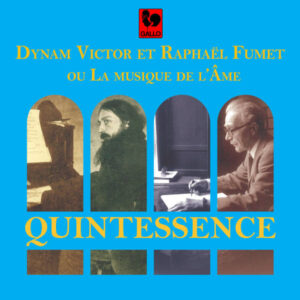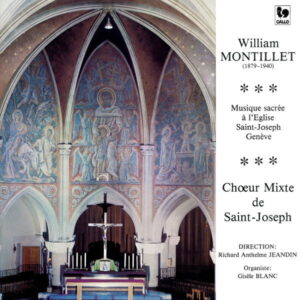Extraits / Excerpts
Nadia Boulanger - René Gerber - Bernard Schulé: Works for Brass Instruments and Organ
Nadia BOULANGER: Trois pièces pour orgue: I. Prélude – II. Petit Canon – III. Improvisation – Pièce sur des airs populaires flamands – René GERBER: Epithalame pour flûte et orgue – Le Tombeau de Grigny: I. Sarabande – II. Comptine – III. Berceuse – IV. Ronde – Fête pour 2 trompettes, 2 trombones et orgue – Pavane pour 3 trompettes et orgue – Triptyque pour orgue: I. Pastorale – II. Musette sur le nom de BACH – III. Fête – Bernard SCHULÉ: Métamorphoses sur un Air ancien, Op. 51.
Anaïs Drago, Violin.
Alisa Gremmo, Flute.
Giovanni Panzeca, Organ.
Riccardo Ceretta, Mattia Gallo, Mauro Pavese, Diego Di Mario, Brass.
Recordings of Compositions by René Gerber for Brass Instruments and Organ
It is difficult for me to remain objective when it comes to the music of our Neuchâtel composer René Gerber. Throughout his career, he never knew how to “market” himself, maintaining absolute discretion. He considered me his “spiritual son,” and in this perhaps undeserved capacity, I accompanied him until his death with almost weekly visits. I am convinced that his music is of very high quality, worthy of the education he received at the École Normale de Musique in Paris.
He composed many works for me, which were performed in Switzerland and France. I also contributed to recordings that are compiled on the CD attached to this file. René Gerber’s music for brass instruments and organ is not well known. However, it is published by the Swiss publishing house Pizzicato in Horgen, which highlights the project.
We therefore want to increase its recognition by releasing a CD with Italian artists from the Piedmont region who are closely connected to this music. To complete this production, we are considering adding organ works by Nadia Boulanger, who was Gerber’s composition teacher at the École Normale de Musique in Paris. Gerber had great respect for “Mademoiselle,” as she was known in the Parisian music world of that time.
Claude Delley,
Directeur artistique de la Fondation René Gerber
The Compositions
Nadia Boulanger, a leading figure on the twentieth-century French music scene, left the four works for organ recorded on this CD. The first three pieces (Prélude, Petit Canon, Improvisation), dating from 1911 and originally written for harmonium, were published for the first time in Abbé Joubert’s collection “Maîtres contemporains de l’orgue” (vol. 1), Paris, Sénart, 1912.
The Prélude, in F minor, consists of a calm theme in the form of a melody accompanied in the key and then presented again in the upper fifth, developed and reformulated in C sharp minor on a dominant pedal. A modulating bridge allows the theme to be heard again in the initial key in a solemn form on the last page, supported by a dense harmonic accompaniment before concluding in F major.
The second composition, a short one-page piece in A minor, is presented in the traditional form of a canon with an octave between the parts. The Improvisation, in E flat minor, is a more freely structured piece: the theme is introduced by the intimate, slightly piercing sound of the oboe, while the carillon-like accompaniment is given over to the roundness of the drone. This is followed by a development tinged with chromaticism, before returning cyclically to the first part by way of conclusion.
The Pièce sur des airs populaires flamands (Variations on Popular Flemish Airs) presents this melody in the traditional form of theme and variations, highlighting the rich palette of timbres of the Tamburini organ.
In the musical tradition of the eighteenth century, tombeaux were instrumental collections composed to honour musicians or famous people. The Tombeau de Nicolas Grigny was probably written as a tribute by René Gerber to Nicolas De Grigny, the great master of the harpsichord and the French Baroque organ, and consists of a suite divided into four movements: two adagios (Sarabande and Berceuse) and two allegros (Comptine and Ronde).
Fête, written for an ensemble of two trumpets, two trombones, and organ, was to have been performed at a televised mass in the Basilica of Notre-Dame in Neuchâtel. Unfortunately, having been prepared too late by the performers and still in manuscript form, René Gerber decided to withdraw the work.
The Pavane, a composition for three trumpets and organ, was dedicated to the wedding of a certain Danielle (whose identity has not been traced), probably a friend of the composer. Solemn in character, the main melody is exposed by a rapid change from one brass voice to another, giving way to a more lyrical and intimate episode in the middle section, repeated with a refrain. Finally, it returns to its original character.
The Triptyque for solo organ was composed in 1943 and is dedicated to Henri Gagnebin, composer, organist, and director of the Geneva Conservatory. The first movement is a Pastorale, in which the theme in E major is played several times in all possible harmonisations, on the keyboard and pedal, even in augmentation; this is followed by a Musette on the name of BACH, in which the well-known fragment “B flat-A-C-B” is treated as the cantus firmus on which the whole short composition is built.
Fête, the third movement that concludes the triptych, is written in the tripartite style of the French toccata. The theme, initially entrusted to the powerful voice of the pedal, is reworked in other keys, also in the manual, ending with its solemn reaffirmation in the final apotheosis.
The Métamorphoses sur un Air Ancien Op. 51 by the Geneva composer Bernard Schulé concludes the recording, marking the transition from the symphonic language of the late nineteenth century to the avant-garde and experimentation of early twentieth-century composers. The theme proposed in the opening bars recalls the beginning of the melody of Psalm 22 by Goudimel, probably referring to another old popular melody already known in the Renaissance.
The Métamorphoses is presented as a varied theme, with each variation set within a broader musical discourse. The general structure of the piece is reminiscent of César Franck’s Trois Chorals, a milestone in nineteenth-century French organ literature to which Schulé certainly refers, even if the language and sensibility have already changed profoundly.
Giovanni Panzeca
- Categories
- Composers
- Interprets
- Booklet













